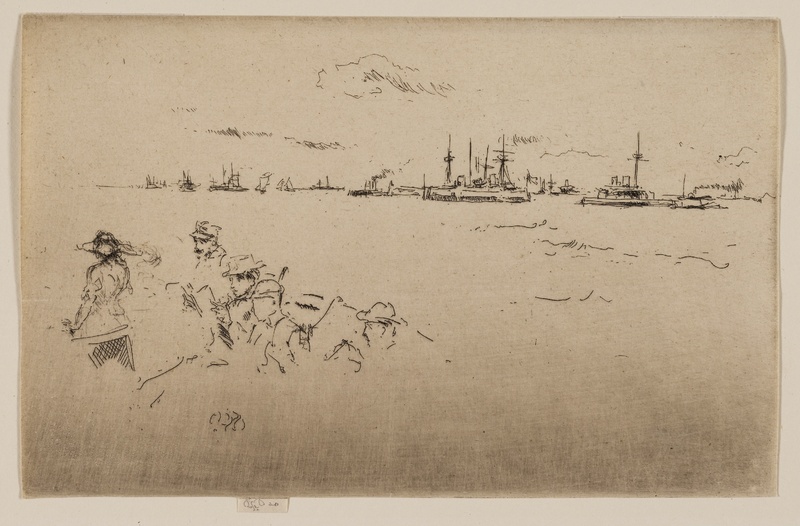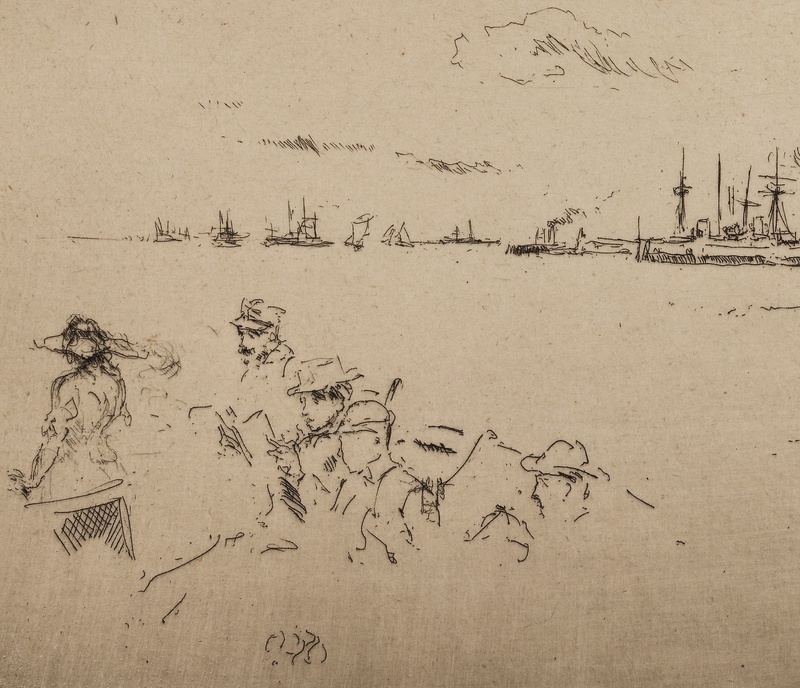J. M. Whistler's "The Fleet: Monitors"
Item
-
Title
-
J. M. Whistler's "The Fleet: Monitors"
-
Description
-
“The Fleet: Monitors” from James McNeill Whistler’s “Jubilee Set” portrays the naval review of Queen Victoria’s 1887 Jubilee and five onlookers. The etching, completed in black ink on laid ivory paper, uses broken lines to outline an array of steam-powered ships with tall masts in the background. Additional ships are depicted with less detail on the left-hand side. Minimal linework suggests the forms of a few clouds in the sky as well as waves in the river. Four men and one woman stand in the left foreground and they all lack facial detail. The woman wears a sunhat and is looking towards the naval display. The first man from the left wears a hat and has a moustache; the second wears a hat and is reading a book; the third and fourth are also wearing hats and are drawn with the least amount of detail. All four men face the foreground, looking away from the ships that make up the background of the etching. The etching as a whole is dominated by negative space, punctuated by thin, spare lines. The paper is textured, and the print featured here, from the collection of the Art Institute of Chicago, has slight discolouration around the edges. Some unevenness in the print tone is evident on the left side of the etching. Relatively small, the print is 14.3 by 22.1 centimetres, or 5.6 by 8.7 inches.
-
SHALINI LE GALL ON WHAT THIS OBJECT TEACHES US:
After attending the 1887 celebrations of Queen Victoria’s fiftieth anniversary as the queen of England, James McNeill Whistler presented her with a set of etchings in a custom-designed album, which became known as the “Jubilee Set.”
Dr. Le Gall contextualizes the "Jubilee Set" by explaining that Whistler first explored representations of the River Thames in a series of prints from the late 1850s. She notes that these earlier prints focus on shipping docks and wharves in detail, depicting colour, atmosphere, and mood, before moving to a more conceptual representation of the Thames as a gateway to the British empire. For Dr. Le Gall, Whistler’s invitation to the jubilee celebrations were crucial to his continuing interest in the Thames and Britain’s maritime power.
Emphasizing Whistler’s connection to Britain’s imperial reach, Dr. Le Gall explains that Whistler was invited to the Jubilee ceremonies in his role as president of the Society of British Artists. She notes Whistler’s request that the Society be newly recognized as the Imperial Society of British Artists. Although the title of Royal Society of British Artists was conferred instead, the request evidences Whistler’s interest in using Britain’s imperial prowess to enhance the Society’s reputation. As Dr. Le Gall explains, the Jubilee emphasized British imperial expansion and Victoria’s long reign: Victoria had recently received the title of Empress of India, and Indian cavalry and princes attended the Jubilee. Whistler and others would have seen these attendees at the ceremonies at Westminster Abbey, and their notability, Dr. Le Gall suggests, is clear in their prominence on Jubilee memorial objects, as on the Queen Victoria Golden Jubilee Plate in the collections of Museums Victoria.
Dr. Le Gall contrasts the commemorative plate’s elaborate decoration and the etching’s spare design. While the plate explicitly identifies Victoria as “Queen and Empress” and highlights Canada, India, and other colonies in purple on a world map to demonstrate the far reach of the British empire, Whistler’s etching in simple black linework appears less explicitly imperialist.
However, Dr. Le Gall argues that the naval review at Spithead demonstrated Britain’s power on the seas. The most prominent ships in Whistler’s print are iron-clad and sport large gun turrets. As Dr. Le Gall notes, their slow speed and short sailing range made them valuable for coastal defence. These ships make up the background, stretching horizontally across the picture plane while several figures make up the etching’s foreground. Notably, only one of these figures, a woman, looks towards the ships. The others, by looking inward, appear disinterested in the naval display. Dr. Le Gall urges us not to take this depiction as evidence of Victorian disinterest in the empire and its naval prowess; rather, naval military themes were so “deeply woven” into marine imagery that they became unremarkable, indistinguishable from the seascape itself.
Dr. Le Gall concludes that the "Jubilee Set," in its entirety, represents Britain’s naval power and technological prowess both in sailing vessels and at the Southampton and Tilbury docks. These representations can become “subsumed in Whistlerian aesthetics,” which focuses especially on air and atmosphere. Yet these aesthetics, as well as Whistler’s artistic identity and self-understanding, were forged in imperial contexts, with the background of British maritime power.



